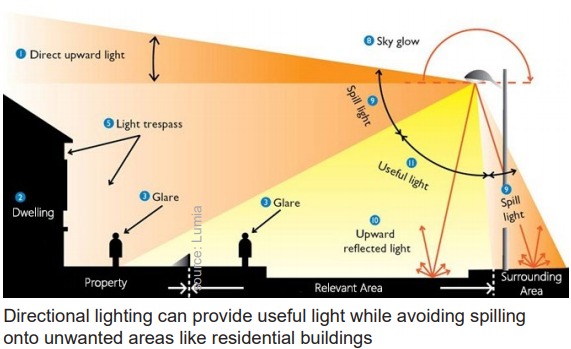For many years now MMA Lighting Consultancy Ltd have been successful in helping customers gain full planning permission on housing development sites. We specialise in helping our customers discharge street lighting related planning conditions where local authorities have specifically requested a lighting impact assessment.
Our lighting impact assessment reports are prepared to assess, in terms of artificial lighting, the likely effects to a surrounding area of a proposed development. We provide lighting assessments that include information on the baseline lighting conditions within the proposed area and consider possible mitigation measures to help reduce potential light spill into neighboring properties at the site boundary. Other very important factors such as ecological receptors, upward light (which can create sky glow) and visual source intensity (glare) are also carefully considered and detailed in our reports. Evaluation of the relevant lighting class will be considered in the report, along with our suggestion on the correct lighting class that should be proposed for the areas in question.
Within our lighting impact assessments we detail and discuss the different types of obtrusive light, the diagram shown below helps to visualize the potential impact of the different types of obtrusive light:-

Lighting impact assessments should consider different areas of legislation, some of the headline legislations are listed below:-
- Professional Lighting Guide PLG 04 “Guidance on Undertaking Environmental Lighting Impact Assessments” Institution of Lighting Professionals (ILP):2013
- Environmental Protection Act 1990 / Clean Neighbourhoods and Environment Act 2005
- National Planning Policy Framework
- BS5489-1:2013 (BS5489-1:2020 introduced in May 2020) Code of practice for the design of road lighting Part 1: Lighting of roads and public amenity areas
- BS EN 13201 2015 – Road Lighting. Performance Lighting
- BS 12464-2:2014 – Light and Lighting. Lighting of Workplaces. Outdoor Lighting.
- Institution of Lighting Professionals, Bat Conservation Trust Lighting Guidance (August 2018)
- Bat Conservation Trust 2014 Interim Guidance
- Guidance Notes for the Reduction of Obtrusive Light; 2020 Institution of Lighting Professionals (ILP)
The deliverables in our lighting impact assessments include the following but can be tailored to suit our customer’s individual needs and anything specifically outlined in a planning condition received:-
- Carry out full ‘Night time site survey’(plus daytime survey if required) including light levels, taken with a light meter, to assess existing baseline conditions
- Prepare and provide ‘Area’ and or ‘Road’ lighting calculations for proposed lighting (Lighting Reality)
- Vertical Illuminance calculations if required (Lighting Reality)
- Provide site specific drawings including Isolux contours to demonstrate light output, specifically at the site boundary (AutoCAD)
- Detailed report containing baseline lighting conditions, lighting category selection process, classified environmental zone for the area in question, ecological receptors, other sensitive receptors, upward light (which can create sky glow) and visual source intensity (glare) and a mitigation strategy aimed at discharging the planning condition(PDF Format)
Additional websites and reference documents that may be of assistance when dealing with lighting impact assessments are detailed below:-
- https://www.gov.uk/guidance/use-of-planning-conditions
- https://theilp.org.uk/
- https://www.bats.org.uk/
- https://www.gov.uk/government/publications/national-planning-policy-framework–2
If you would like to discuss a lighting impact assessment with us, then please feel free to give us a call on 0118 321 5636. We will be more than happy to talk through the best approach and hopefully work with you to assist in gaining full planning permission. Alternatively please send your enquiry to info@mma-consultancy.co.uk and we will get back to you as quickly as we possibly can.
